#jianfa
Explore tagged Tumblr posts
Text
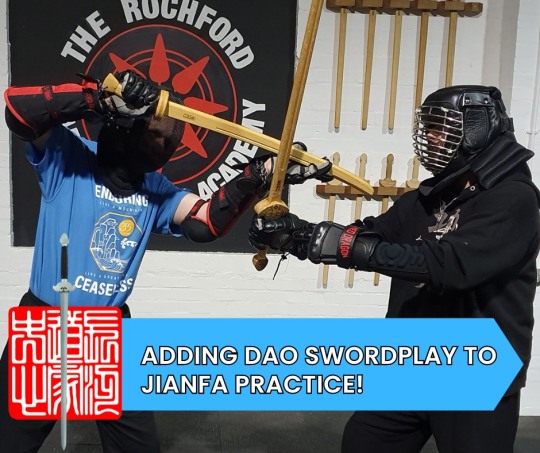
Merging Jianfa & Daofa in Your Swordplay:
Practitioners of Jianfa looking to explore the depths of Chinese swordsmanship, incorporating Daofa, the art of the saber, can add a more assertive, power orientated flavor to your swordplay.
This journey is not just a weapons switch up; it's about expanding your mindset, augmenting your skill set, while broadening your approach to swordsmanship.
In this guide, we'll navigate through the transition, focusing on practical techniques and insights to enhance your martial arts skills.
The Jian, with its straight, double-edged blade, epitomizes precision, agility, and adaptability, demanding a level of finesse and fine movement.
In contrast, the Dao, featuring heavier cuts, is a single-edged blade, representing power and efficiency in combat.
Uniting Daofa with Jianfa involves more than learning to handle a different sword, it means embracing a different approach in swordplay.
The Dao's point of balance is more forward than the Jian’s. This provides for more powerful cuts and thus a significant shift in technique. Daofa focuses not on the quick, wrist-led maneuvers that are the essence of Jianfa, instead focusing on powerful, elbow-driven techniques.
This style engages larger muscle groups for stronger and more impactful strikes, a key aspect in effectively wielding the Dao.
Starting with Pi Cut from Stirring Deflection
Begin your transformation with a drill common to both Jianfa and Daofa, the Pi cut from a stirring deflection. This provides a familiar base while introducing Dao's unique handling characteristics.
Chan involves a binding or wrapping movement, where the blade circles the body. It's a deflecting technique where the flat of the blade is used to deflect an incoming cut on one side of the body and then continues the motion to circle the blade around the torso, behind the back. This allows for a follow-up cut from the opposite side.
Deflecting with a Chan movement, the empty hand moves inside the blade, close to the chest, and can be employed to momentarily control the opponent’s sword arm as one advances forward. Training this technique introduces practitioners to the closer, more direct combat style found in Daofa. In contrast, Jianfa's prefers maintaining a distance that provides space to maneuver.
After gaining familiarity with the Pi and Hua cuts, it's insightful to progress to the distinctively heavier Kan cut. The Kan is and unique to saber systems, not being present in Jianfa.
Following this, the Duo cut would be the next logical cut to add. While the Duo cut is also present in Jianfa, it’s not made use of as frequently when wielding the straight sword.Training Daofa’s use of the Duo reminds us of why we are evolving our swordplay, merging the mindsets of Jianfa and Daofa, mixing more aggressive and assertive actions into our sword work.
In practice, although the timing of the Duo cut may appear similar to its Jianfa counterpart, it requires a considerably larger window of opportunity, reflecting the bolder and more direct approach of Daofa.
This exploration into the Duo cut provides practitioners with a new perspective on the rhythm shift from the more measured Jianfa to the dynamic and forceful Daofa.
The Pi cut can be likened to the power needed to trim a leaf off a tree, the Kan cut to chopping a thick branch, and the Duo cut to the robust action of felling an entire tree or splitting a log. This progression not only illustrates the escalating power inherent in Daofa techniques but also underscores the distinct tactical mindset required for this style of swordplay.
The Gua cut, though mechanically akin to the Liao cut in Jianfa, takes on a unique role in Daofa. It focuses an aggressive sweeping action to proactively capture the line, reflecting Daofa's assertive and power-oriented nature of Dao swordplay.
Incorporating shield work, especially with durable circular cost effective riot shields, provides insight into how the Dao would have been wielded on the battlefield. This practice not only enhances sword skills but also offers a better understanding of strategic defense and offense in historical combat contexts.
You can use a rattan Tengpai, but these are a lot more costly than a riot shield, which are far cheaper and will hold up to virtually anything you can throw at it during swordplay.
These individual cut drills can be combined into dynamic semi-fixed sparring routines, crucial for experiencing the reactive and adaptive nature of Daofa and preparing for unpredictable combat situations.
Merging Jianfa to Daofa offers an opportunity to evolve your understanding of Chinese swordsmanship, introducing new techniques and strategic thinking. It also adds tactical options to your swordplay, making you less predictable. This journey, embraced with dedication and an open mind, not only enhances your swordplay skills but also enriches your overall approach to swordsmanship. Enjoy the growth and mastery that come with learning the powerful art of the Daofa.
—----
All of the drills and cuts discussed in this guide can be found in the Daofa sections of the Academy of Chinese Swordsmanships Online Archives. Available to all members of the Daofa and Sword Scholars Study paths.
Visit www.chineseswordacademy.com for more details.
#chineseswordsmanship#jianfa#duanbing#chinesemartialarts#chineseswordplay#chineseswordfighting#scottmrodell#jianshu#daofa#scottrodell#daoistswordarts#chineseswordarts#swordfightingclasses#ukchineseswordfighting#taijijian#taijiswordfencing#taijisword#wudangsword#wudangjian#taijidao#taijisaber#swordfightingschool#kungfuweapons#swordfightingskills#chineseswordwork#swordtraining#劍法#刀法#chinesesword#yangjiamichuantaijijian
12 notes
·
View notes
Text
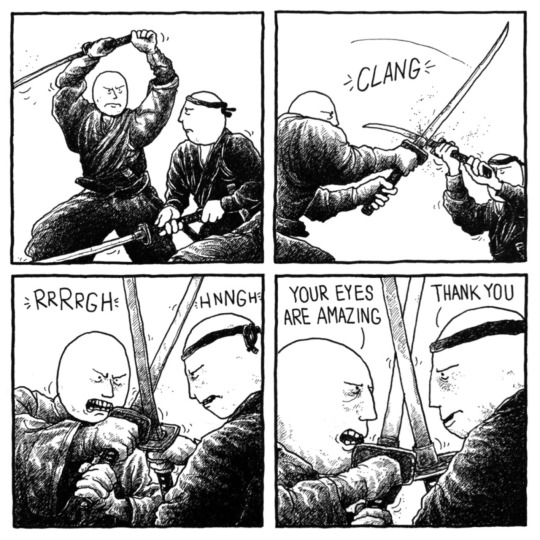
© Jake Likes Onions
#martial arts#combat#duel#sparring#humor#humour#martial arts school#swordplay#swordsmanship#chinese sword#sword#sword art#swords#jianfa#jian#katana#samurai#ninja#katana man#saber#daofa#swordsman#meme#meme humor#comics
11 notes
·
View notes
Text
SVSSS Monster Hunter AU
Monsters I want Shen Yuan/Qingre to have as familiars!! For how this is going to work, Shen Yuan is going to have a set limit on how many familiars he can take out and about based on the strength of his cultivation and the size/power of the monsters themselves. The reason for this is bc at some point his kinship stone broke which shattered the empathetic bond between him and his familiars, but he can rebuild it with a maximum of 3 monsters at once. He doesn't need the empathy bond on Wu Nian peak bc he has more time to understand what his familiars are trying to communicate, but outside the peak its more necessary for quick communication during battle.
For my own sake there will be three sizes of monsters: 1st, 2nd, and 3rd class monsters. 3rd class monsters are monsters that cannot be ridden, 2nd class monsters are monsters that one to three people can ride, and 1st class monster can be ridden by 4+ people.
My understanding of "riding" implies that the monster is not impeded by being ridden. Thus the entirety of the Wingdrakes are 3rd class monsters, and Shen Yuan can have three empathetically tied to him at once, and Paolumu and Tobi-Kadachi are 2nd class monsters so Shen Yuan can have two empathetically tied simultaneously, whereas Najarala or Beotodus are 1st class monsters so Shen Yuan can only have one empathetically tied to him.
Lets get started! first off: Paolumu! Shen Yuan's paolumu is named Mimi [糸糸], the character meaning fine silk repeated twice. Mimi is a 2nd class Flying Wyvern from the Coral Highlands in the New World, and one person can ride her. Mimi is 14m long, is weak to fire and thunder, and resists water.
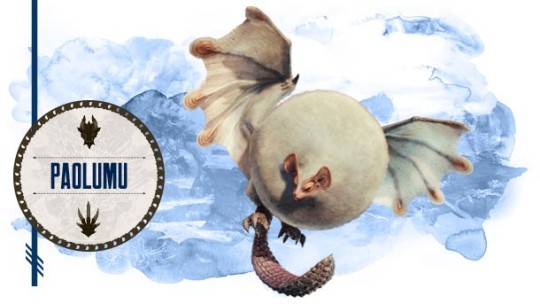
next, Tobi-Kadachi! Shen Yuan's Tobi-Kadachi is named Dalei [打雷], meaning the sound of thunder. Dalei is a 2nd class Fanged Wyvern from the Shrine Ruins in the Old World, and two people can ride him. Dalei is 15m long, can attack with thunder, can inflict thunder-blight, is weak to water, and resists thunder.
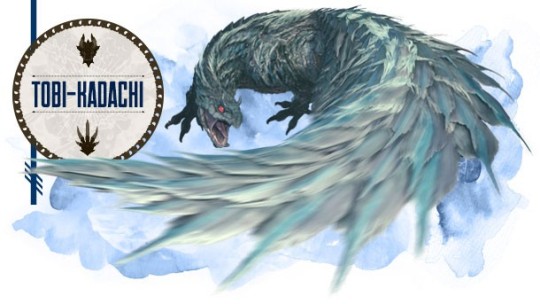
Shen Yuan's Malfestio is named Wuyao [乌药], meaning crow/raven/black and leaf of the iris (flower). Wuyao is a 3rd class Bird Wyvern from the Jurassic Frontier of the Old World, and cannot be ridden. Wuyao is 3m long, can inflict confusion and sleep, and is weak to fire and water.
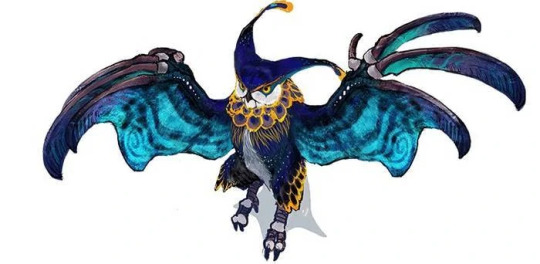
Shen Yuan's Glavenus is named Jianfa [剑法], meaning sword play. Jianfa is a 1st class Brute Wyvern from the Ingle Isle of the Old World, and 5 people can can ride her. Jianfa is 31m long, can attack with fire, can inflict fire-blight and bleed, is weak to dragon, water, and ice, resists thunder, and is immune to fire.
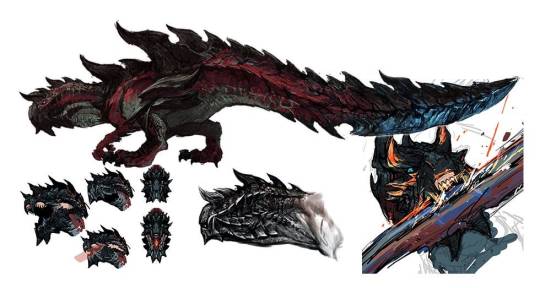
Shen Yuan's Seregios is named Cici [刺刺], the character meaning thorn/spike/to stab repeated twice. Cici is a 2nd class Flying Wyvern from Pondry Hills in the Old World, and is the oldest of Shen Yuan's companions. Only one person can ride Cici. Cici can inflict bleed, and is weak to thunder and ice.
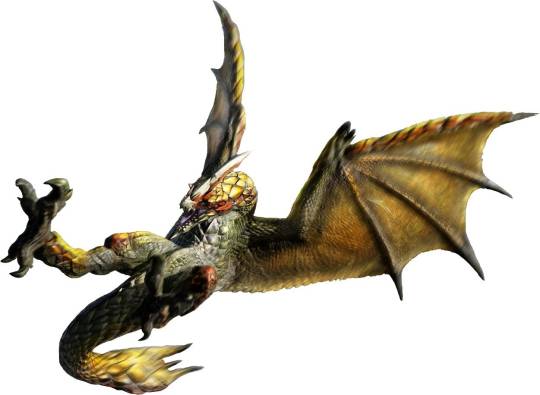
Shen Yuan's Lagaicrus is named Houya [厚牙], meaning to favour ivory. Houya is a 2nd class Leviathan from Paupau Beach of the Old World, only one person can ride her. Houya can attack with thunder and water, can inflict thunder-blight and water-blight, and is weak to fire and dragon.
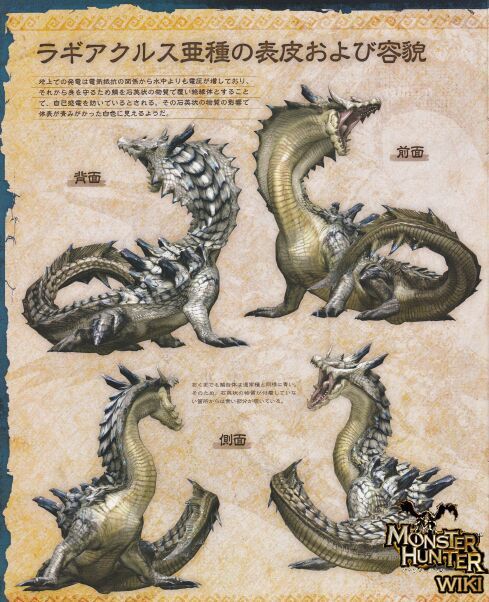
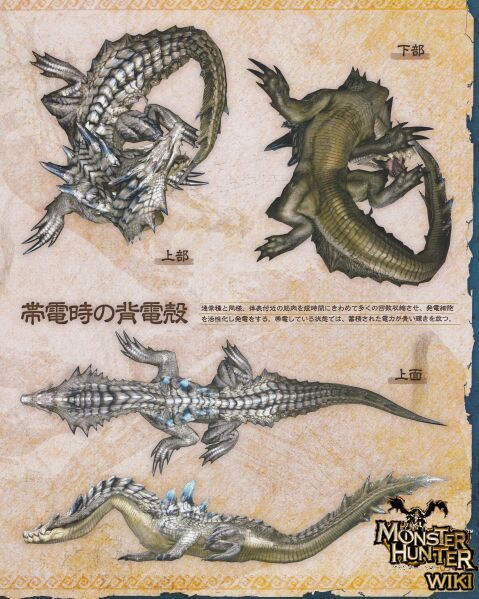
Shen Yuan's Midogaron is named Yaoban [耀斑], meaning solar flare. Yaoban is a 2nd class Fanged Beast from the Old Swamp of the Old World, only one person can ride her. Yaoban can attack with fire, can inflict stun, and is weak to water and ice.
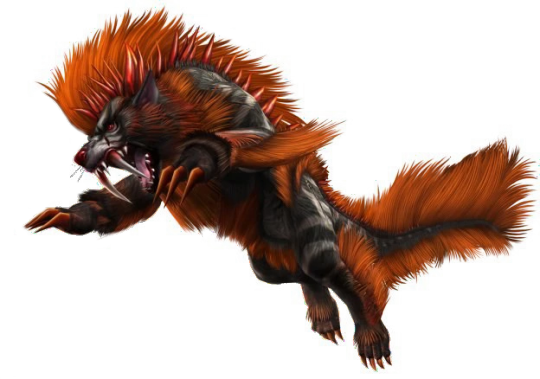
Shen Yuan's Odogaron is named Juli [咀璃], meaning eating glass. Juli is a 2nd class Fanged Wyvern from the Rotten Vale of the New World, and can be ridden by two people. Juli can attack with dragon, can inflict dragon-blight and bleed, is weak to water, and resists dragon.
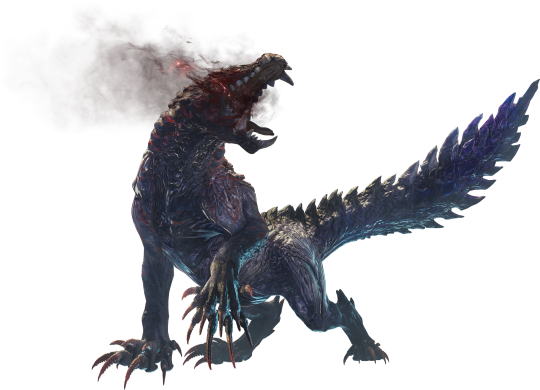
Shen Yuan's Beotodus is named Taxue [踏雪], which means to go for a walk in the snow. Taxue is a 1st class monster from the Hoarfrost Reach of the New World. He can carry six people. Taxue is 22m long, can attack with ice, can inflict ice-blight, is weak to thunder and fire, resists water, and is immune to dragon and ice.
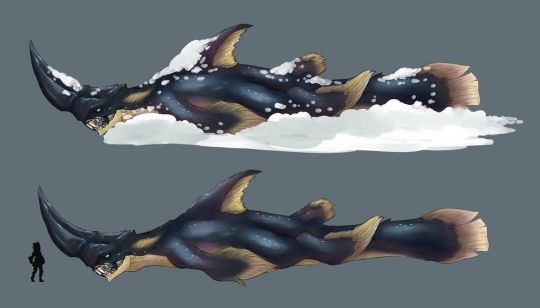
Shen Yuan's Banbaro is named Tianma [甜马], meaning sweet horse. Tianma is a 1st class monster from the Hoarfrost Reach of the New World. She can carry eight people. Tianma is 29m long, can attack using fire, water, and ice (dependent on terrain), can inflict fire-blight, water-blight, and ice-blight (dependent on terrain), is weak to dragon and fire, resists thunder, and is immune to water and ice.

Shen Yuan's Najarala is named Fense [魵色], which means shrimp colours. Fense is a 1st class Snake Wyvern from the Everwood of the Old World. Fense is 52m long, can attack with water, can inflict water-blight and paralysis, and is weak to fire and thunder.
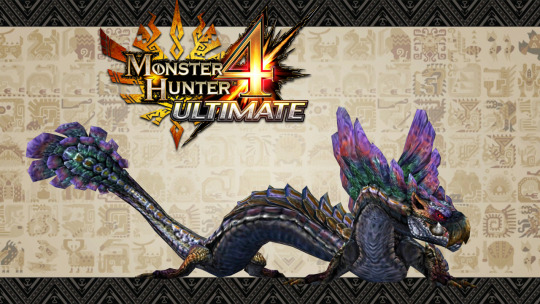
Finally, Shen Yuan's Nerscylla is named Shaoling [蛸绫], meaning silk spider. Shaoling is a 2nd class Temnoceran from the Trese Desert of the Old World, only one person can ride her. Shaoling is 11m long, can inflict paralysis, poison, and noxious poison, can bind things in her web, and is weak to ice and fire.
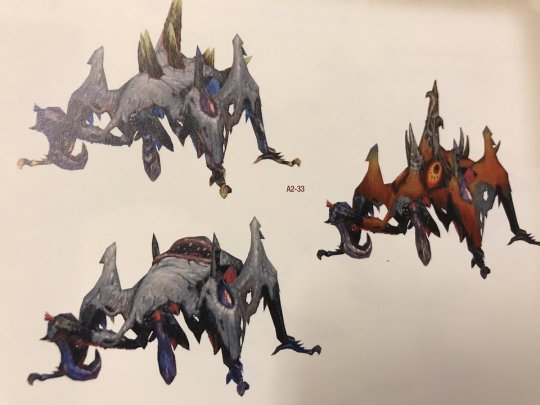
#i need to organize these fuckers in a doc#monster hunter#monster hunter shen yuan#svsss monster hunter au#shen qingqiu#shen yuan#svsss#mxtx svsss#scum villian self saving system#long post#svsss fanfiction#grim's notes#links#multiple links
7 notes
·
View notes
Text
Unsheathing History: The Mastery of Chinese Swords
In the rich tapestry of Chinese history and culture, the art of crafting swords holds a distinguished place. Chinese swords, with their storied past and remarkable craftsmanship, are more than just weapons; they are symbols of tradition, honor, and martial prowess.

Chinese swords can be broadly classified into two main categories: jian and dao. The jian, often referred to as the "gentleman of weapons," is characterized by its straight, double-edged blade. This design is ideal for swift, precise strikes and has been a symbol of nobility and martial virtue for centuries. The dao, on the other hand, features a single-edged curved blade and is known for its cutting power and versatility in combat.
These swords are not only remarkable for their functionality but also for their artistic value. Chinese swordsmiths have perfected the art of blade forging, creating intricate designs and patterns on the steel. The blades are often adorned with ornate hilts and scabbards, showcasing the fine craftsmanship and attention to detail that goes into making each sword a work of art.
Chinese swords have played an integral role in Chinese martial arts, where they are revered as an extension of the martial artist's spirit. The discipline of using these swords, known as "jianfa" or "daofa," is an essential component of traditional martial arts, emphasizing precision, grace, and discipline.
In conclusion, if you are intrigued by the history, artistry, and martial significance of Chinese swords, explore our collection at https://monkeyofferspeach.com/collections/weapons.
We offer an array of authentic Chinese swords that embody the essence of this time-honored tradition. Each sword tells a story, and owning one is like possessing a piece of China's martial heritage. Dive into the world of Chinese swords and discover the craftsmanship, culture, and elegance they represent.
1 note
·
View note
Text
I can’t talk about fencing to sport HEMA guys because inevitably I end up convincing them I’m insane and wrong because I’m a coward or my fencing isn’t sufficiently violent or athletic enough or whatever. I can only talk about fencing with people who are equally freaky about traditional martial arts, which is fine except now I’m seriously considering taking the time to learn jianfa instead of like, sleeping. Which come to think of it is a great idea actually
1 note
·
View note
Photo

Impressions of the Martial Forest 武林风范 – Sun Jianyun 孙剑云
#Baguazhang#Chinese martial arts#Chinese Swordsmanship#Internal Martial Arts#Jianfa#kung fu#Neijiaquan#tai chi#tai chi chuan#Taijiquan#Tim Cartmell#Xingyiquan
2 notes
·
View notes
Photo

"Have patience. All things are difficult before they become easy." —Saadi [1400x1000]
0 notes
Photo

yinchuan vanke metropolis bring back elegance from neoclassic era: project by mind design
the cognition of world culture is always changing. yinchuan vanke metropolis emerged with its fully new and strong commercial and artistic concept. the project was built jointly by the mind design and developer teams. with its distinctive aesthetic style and multi-dimensionally extended spatial perspectives, it stimulates and promotes the operation of the city by use of criticization, breaking, and creation. since vanke mid-lake island in xiamen, the vanke metropolis series has expanded across china over the past 10 years, from the first-tier cities in eastern china to those in central and western china. every commercial expansion is a bold attempt at urban planning and operation modes, and also an iterative change of design and living concepts. the vanke metropolis project also continues its noble, elegant, and post-modern architectural features, while its plain colors harmonize with the cultural, historical, environmental, and other elements of northwest china in yinchuan. from the inner courtyard into the community lobby, this is a place to interrupt city noises. its elegant and soft design provides a buffer zone between indoor movement and outdoor tranquility, and between outer roughness and inner delicacy. it also promotes a dialogue between people and the environment, and between the mind and the world. an exquisite urban complexyinchuan vanke metropolis is located in the central life district (cld) planned by the government, neighboring the southern business district under construction in yinchuan, covering wanfang shopping center, jianfa youyue city, and yinchuan cultural park, and adjacent to qizilian lake with an area of 4,000 mus on the east. such superior geographical location and rapid urban changes have prompted builders to make a difference. read the full story https://bit.ly/33cP0Gu
2 notes
·
View notes
Text
Yinchuan Vanke Metropolis, Ningxia
Yinchuan Vanke Metropolis Sales Center, Chinese Retail Interior, Architecture Photos
Yinchuan Vanke Metropolis in Ningxia Province
27 Apr 2021
Yinchuan Vanke Metropolis
Architecture: Mind Design
Location: Yinchuan, Ningxia, China
Space For Urban Dimensions The cognition of world culture is always changing. Yinchuan Vanke Metropolis emerged with its fully new and strong commercial and artistic concept. The project was jointly designed and built jointly by the Mind Design and developer teams. With its distinctive aesthetic style and multi-dimensionally extended spatial perspectives, it stimulates and promotes the operation of the city by use of criticization, breaking and creation.
Elegance From Neoclassicism Since Vanke Mid-lake Island in Xiamen, the Vanke Metropolis series has expanded across China over the past 10 years, from the first-tier cities in eastern China to those in central and western China. Every commercial expansion is a bold attempt at urban planning and operation modes, and also an iterative change of design and living concepts.
The Vanke Metropolis project also continues its noble, elegant and post-modern architectural features, while its plain colors harmonize with the cultural, historical, environmental and other elements of northwest China in Yinchuan.
From the inner courtyard into the community lobby, this is a place to interrupt city noises. Its elegant and soft design provides a buffer zone between indoor movement and outdoor tranquility, and between outer roughness and inner delicacy. It also promotes a dialogue between people and the environment, and between mind and the world.
An Exquisite Urban Complex Yinchuan Vanke Metropolis is located in the central life district (CLD) planned by the government, neighboring the southern business district under construction in Yinchuan, covering Wanfang Shopping Center, Jianfa Youyue City and Yinchuan Cultural Park, and adjacent to Qizilian Lake with an area of 4,000 Mus on the east. Such superior geographical location and rapid urban changes have prompted builders to make a difference.
The developer and Mind Design teams originally conceived an urban complex to create supporting facilities for a life community, and a functional planning clearly different from traditional sales departments. Therefore, the criticalness and originality of spatial function and design can be seen everywhere in the interior space.
The corridor of the Open Audio-Video Area was inspired by and benchmarked with Fifth Avenue in New York. A large number of LED screens were installed here to highlight the commercial atmosphere and technological sense of the integrated exhibition area, and to improve the prosperous living experience in southern Yinchuan.
The developer and Mind Design teams hope that this kind of indoor and outdoor brand exhibition can reflect the senses of fullness and quality of the project in the early stage. In combination with large facilities such as Youyue City, the cooperation between Vanke and Jianfa would generate a complex with the best quality and the best supporting facilities in Yinchuan.
The construction of the large complex Jianfa Youyue City will be completed soon, and the density and concentration of consumers will soar as a result. A large proportion of real estate contracts of Yinchuan are concluded for projects in South Yinchuan currently. Therefore, for the convenience of customers, a more convenient and contract signing center integrating banking was created jointly by the developer and Mind Design teams as required by the actual situations.
In addition to the Contract Signing Center, the design team also designed a rest area for family members inspired by airport lounges. It is equivalent to creating a place to serve their families for Vanke owners in the Vanke Metropolis community, even it is close to the bustling business district.
A scenario is expected in the future, where a wife does some shopping in Youyue City, while her husband is playing games and drinking afternoon tea in the Rest Area, both enjoying the community service and waiting for his wife at the same time. All Vanke owners can come here to rest, and their independent sense of dignity is strengthened from the perspective of configuration.
Based on the neoclassical tone, the overall interior space of the Metropolis project integrates the essence of Greek and ancient Roman classicism, namely, elegance and delicacy, forming a strong contrast with the rough style of Yinchuan which is located outside the Great Wall in northwest China. The designers decorated modernism with the traditions of classicism, took natural materials as the media, and adopted contemporary design thinking and aesthetics to create a neoclassical real estate club which looks lightly luxury.
Luxurious Ultimate Aesthetics Wang Dacheng, the founder of Mind Design, commented that design is the art to serve the visual feeling of persons, and they always design projects only after both owners and consumers are satisfied with their design proposals.
As a new model of urban space, modern high-quality life supporting facilities need to be emphasized with thick and heavy colors. Therefore, Bulgari’s classic aesthetic style has become the main concept of this project in the discussion between developer and Mind Design teams.
Bulgari’s history of nearly 137 years has not only witnessed the evolution of the Italian classical culture, but also constituted an important chapter in the development history of the world’s top jewelry art. Its distinctive aesthetic style also forms a model of interior design in the world.
The project belongs to the Vanke Metropolis series. The Mind Design team was attracted by Bulgari when designers were looking for a new story line and the most moving elements during planning the project, in addition to the Metropolis style at which they are good.
Bulgari itself is a classic of luxury goods in the world. Its color tone is elegant, deep and warm, and thus quite suitable for Yinchuan’s tone and weather. Therefore, the whole project is full of noble and luxurious temperament, from the inner courtyard to the landscape and interior.
The design team has upgraded the original Metropolis style, so that it is of more dignity, topicality and theme-orientation, which fill the gap of local architectural styles in Yinchuan and also wins good response from consumers.
The designers cleverly combined classical and modern elements by integrating the iconic aesthetic features of Bulgari into minimalism through the collision of black and other colors, and meanwhile reinterpreted the unique elegance and nobility of the space by combining the design language of the building itself.
With the increasing scale of the business district around the Metropolis project, there will be more and more catering space. The developer and Mind Design teams intended to provide a different dining space with better hardware and more privacy, so as to provide owners another choice for more convenient private banquets. Considering the characteristics of local halal food in Yinchuan, the designers created many professional kitchen configurations and design elements.
By breaking the whole into parts and assembling parts into the whole, the designers made compound and diverse functional planning for rich service scenarios. Yinchuan Vanke Metropolis combined those supporting facilities above and below ground to create an eternal urban classic project with its experiential sales center, super avant-garde life perspective, ultimate color aesthetics, and international viewpoint.
Yinchuan Vanke Metropolis in the Ningxia Province – Building Information
Project Name: Yinchuan Vanke Metropolis Project Location: Yinchuan Ningxia Owner: Yinchuan Vanke Interior Area: 2,153 sqm Interior Design: Mind Design Soft Decoration Design: Mind Design Construction Company: Mind Design Architectural Design: Arch-age Design (Chongqing) Owner’s Team: Hu Sizhe & Ding Liuyuan
Photography: Zhang Qilin
Yinchuan Vanke Metropolis, Ningxia images / information received 270421
Location: Yinchuan, Ningxia, People’s Republic of China
Architecture in China
Contemporary Architecture in China
China Architecture Design – chronological list
Chinese Architect – Design Practice Listings
Yiwu Cultural Square, Zhejiang Province Architect: The Architectural Design & Research Institute Of ZheJiang University Co,Ltd photograph : Qiang Zhao Yiwu Cultural SquareBuilding
Shuyang Art Gallery, Suqian City, Jiangsu Province Design: The Architectural Design & Research Institute Of ZheJiang University Co,Ltd photograph : Qiang Zhao Shuyang Art Gallery Building
Xi’an Architecture
White Comedy of Xi’an Zhongshu Bookstore Design: Wutopia Lab photograph : CreatAR Images White Comedy of Xi’an Zhongshu Bookstore in Shanxi
Qujiang Creative Circle in Xi’an Design: Oval Partnership photograph : Zhang Qilin Qujiang Creative Circle in Xi’an
Metropolis Sales Center Design: ONE-CU Interior Design Lab photograph : Zhang Qilin Metropolis Sales Center in Xi’an
Baqiao Housing Xi’an Architects: Leo A Daly image courtesy of architects Xi’an Housing, Shaanxi
Xi’an International Horticultural Expo Design: Plasma Studio Xi’An World Fair 2011
Flowing Gardens Design: Plasma Studio Flowing Gardens, Xi’an Building
ORB Media Group Xi’an Exhibition
Chinese Architecture
Comments / photos for the Yinchuan Vanke Metropolis, Ningxia page welcome
Website: Yinchuan, China
The post Yinchuan Vanke Metropolis, Ningxia appeared first on e-architect.
1 note
·
View note
Photo
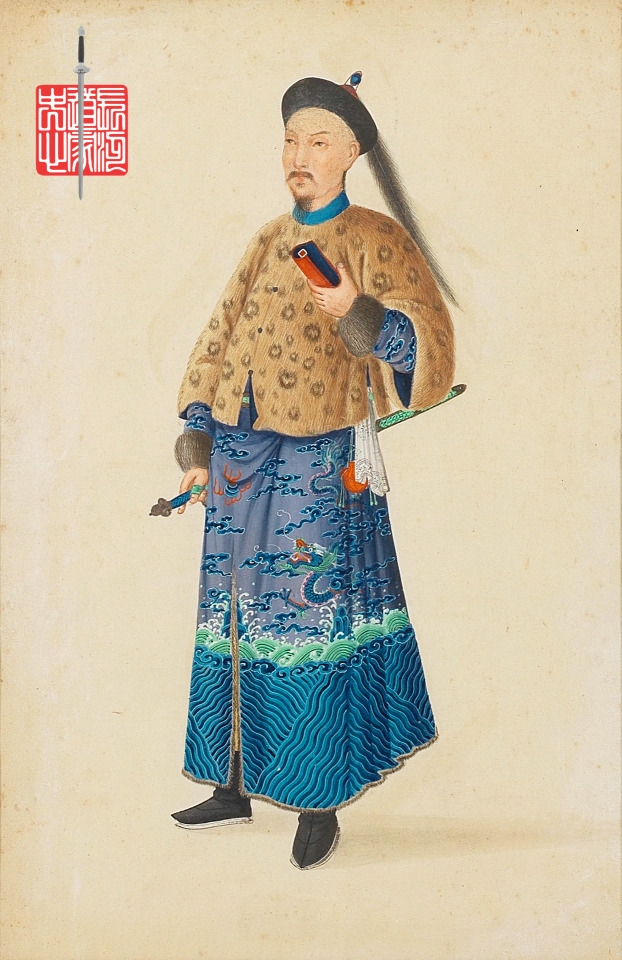
A High Qing Officer
Armed with a Jian. The vast majority of Manchu Bannermen carried dao, so it is quite unusual to see an official armed in this fashion.We know he is a Bannerman by the green jade thumb around his right thumb.Thumb rings were worn as a symbol of their status as Qiren. One might think that his man was left handed given that he is wearing his sword on his right hip. But the thumb ring on his right thumb indicated he was indeed right handed. Perhaps there were some social situations where those armed were required to wear their swords on the opposite hip to prevent a quick draw. If this is the case, I am unaware of such a tradition in China. My suggestion is pure speculation. It is also quite possible that the artist simple decided he liked this look better and the swords position on the right hip has nothing to do with how it was actual worn.
19th Century, Chinese School Painting.
#zhongguojianfa#jianfa#chineseswordsmanship#historicalswordsmanship#swordsmanship#chineseswordfighting#swordfighting#duanbing#chineseswordwork#swordwork#swords#chineseswordarts#daoistswordarts#swordarts#swordart#chineseswordart#taijiswordfencing#swordfighter#中國劍法#劍法#劍#kungfuweapons
37 notes
·
View notes
Text
The Ill-fated Tai Chi Sword Fingers: Just No Need
A few words about this scourge of internal styles, “sword fingers���, also known as “sword mudra” and “sword hex” (劍訣 or 劍指). Having found them in the manual, the human mind expects to discover a rational justification for them as well. If the sword fingers are in the form, then they are needed somehow. After all, the wise ancient Chinese could not just say nonsense … Continue reading Untitled

View On WordPress
#Chinese history#Chinese martial arts#Chinese sword#Chinese swordsmanship#jian#jianfa#sword#sword fingers#swordplay#tai chi#tai chi jian#taiji#Wudang sword
0 notes
Text
#education - Learn western subjects in mandarin by China students waste time, money and energy via /r/China

#education - Learn western subjects in mandarin by China students waste time, money and energy /r/ideas_jianfa/comments/ghe7xy/education_learn_western_subjects_in_mandarin_by/ Submitted May 10, 2020 at 06:37PM by jianfa-ben-tsai via reddit https://ift.tt/2WL0Ofr
0 notes
Photo

Chinese Swords & Swordsmanship: Taking the On Guard Ready Stance
#Baguazhang#Chinese martial arts#Chinese Swordsmanship#Daofa#Great River Taoist Center#GRTC#Internal Martial Arts#Jianfa#kung fu#Neijiaquan#Scott M. Rodell#tai chi#tai chi chuan#Taijiquan#Xingyiquan#yang family tai chi chuan#yangjia taijiquan
0 notes
Text
How to protect yourself when you visit "sensitive" websites
Share your tips too :)
Use a dedicated computer or tablet for "sensitive" websites viewing ONLY. Use a dummy email account, a separate not admin rights computer user account for that dirty computer. Better yet, use guest mode. Keep it simple. Tape webcam. Disable microphone. No apps, nothing. Only browser.
Always log out of websites and apps immediately after use. Never give your real credit or debit card number to view live cam or pay for sensitive website subscription. When you are connected to live cam, the other party would record you and use the session to blackmail you. The other party could send you supposedly special video or photos but are spyware to mine your financial bank log in and empty your bank accounts or other creative criminal scenarios. Your online live sessions are recorded to blackmail you to turn you into their criminal and/ or to sabotage your own company so your company's competitor that hire the criminal can profit.
Australia Cybersecurity Centre >> https://www.cyber.gov.au/
Agency Cybercrime Australian Cybercrime Online Reporting Network (ACORN) >> www.acorn.gov.au
Stay Smart Online Service—www.staysmartonline.gov.au • CyberSmart website—www.cybersmart.gov.au • Stay Smart Online guides—available at www.staysmartonline.gov.au/get-involved/guides
Australian Communications and Media Authority (ACMA) >> www.acma.gov.au or call the ACMA Customer Service Centre on 1300 850 115
How to protect yourself when you visit "sensitive" websites
https://www.reddit.com/r/cybersecurity/comments/fsaaqd/how_to_protect_yourself_when_you_visit_sensitive/
Stay Safe Web Browsing
https://www.reddit.com/r/cybersecurity/comments/fs8pu4/stay_safe_web_browsing/
How do you know you are hacked?
https://www.reddit.com/r/cybersecurity/comments/fs9t76/how_do_you_know_you_are_hacked/
What should you do if you have been hacked?
https://www.reddit.com/r/cybersecurity/comments/fs9lbp/what_should_you_do_if_you_have_been_hacked/
Software Cybersecurity Tips
https://www.reddit.com/r/cybersecurity/comments/fs9hjj/software_cybersecurity_tips/
Work Cybersecurity Tips
https://www.reddit.com/r/cybersecurity/comments/fs8lsg/work_cybersecurity_tips/
Social Media Cybersecurity Tips
https://www.reddit.com/r/cybersecurity/comments/fs9f52/social_media_cybersecurity_tips/
How to protect yourself from Social Engineering scams
https://www.reddit.com/r/cybersecurity/comments/fs9jxg/how_to_protect_yourself_from_social_engineering/
How to protect your phone
https://www.reddit.com/r/cybersecurity/comments/fs9p5l/how_to_protect_your_phone/
How do you secure your computer physically?
https://www.reddit.com/r/cybersecurity/comments/fs9rz8/how_do_you_secure_your_computer_physically/
How do you educate your family members to reduce hack risks?
https://www.reddit.com/r/cybersecurity/comments/fs9uu6/how_do_you_educate_your_family_members_to_reduce/
How to enhance your email security?
https://www.reddit.com/r/cybersecurity/comments/fs9w7y/how_to_enhance_your_email_security/
Learn examples of Cyber scams so you can protect yourself - Part 1
https://www.reddit.com/r/cybersecurity/comments/fslce5/learn_examples_of_cyber_scams_so_you_can_protect/
Learn examples of Cyber scams so you can protect yourself - Part 2
https://www.reddit.com/r/cybersecurity/comments/fsldz8/learn_examples_of_cyber_scams_so_you_can_protect/
How to keep your money secured
https://www.reddit.com/r/cybersecurity/comments/fslhtw/how_to_keep_your_money_secured/
How to secure passwords in 29 ways
https://www.reddit.com/r/cybersecurity/comments/fsaidv/how_to_secure_passwords_in_29_ways/
submitted by /u/jianfa-ben-tsai [link] [comments] source https://www.reddit.com/r/sexover30/comments/fsm2f6/how_to_protect_yourself_when_you_visit_sensitive/
0 notes
Text
Yinchuan Vanke Metropolis, Gansu Province
Yinchuan Vanke Metropolis, Gansu Province Interior Architecture, Chinese Commercial Building Photos
Yinchuan Vanke Metropolis in Gansu Province
26 Oct 2021
Architecture: Mind Design
Location: Yinchuan, Ningxia, China
Yinchuan Vanke Metropolis
The cognition of world culture is always changing. Yinchuan Vanke Metropolis emerged with its fully new and strong commercial and artistic concept. The project was jointly designed and built jointly by the Mind Design and developer teams. With its distinctive aesthetic style and multi-dimensionally extended spatial perspectives, it stimulates and promotes the operation of the city by use of criticization, breaking and creation.
Elegance From Neoclassicism The Vanke Metropolis project also continues its noble, elegant and post-modern architectural features, while its plain colors harmonize with the cultural, historical, environmental and other elements of northwest China in Yinchuan.
Since Vanke Mid-lake Island in Xiamen, the Vanke Metropolis series has expanded across China over the past 10 years, from the first-tier cities in eastern China to those in central and western China. Every commercial expansion is a bold attempt at urban planning and operation modes, and also an iterative change of design and living concepts.
From the inner courtyard into the community lobby, this is a place to interrupt city noises. Its elegant and soft design provides a buffer zone between indoor movement and outdoor tranquility, and between outer roughness and inner delicacy. It also promotes a dialogue between people and the environment, and between mind and the world.
An Exquisite Urban Complex Yinchuan Vanke Metropolis is located in the central life district (CLD) planned by the government, neighboring the southern business district under construction in Yinchuan, covering Wanfang Shopping Center, Jianfa Youyue City and Yinchuan Cultural Park, and adjacent to Qizilian Lake with an area of 4,000 Mus on the east. Such superior geographical location and rapid urban changes have prompted builders to make a difference.
The developer and Mind Design teams originally conceived an urban complex to create supporting facilities for a life community, and a functional planning clearly different from traditional sales departments. Therefore, the criticalness and originality of spatial function and design can be seen everywhere in the interior space.
The corridor of the Open Audio-Video Area was inspired by and benchmarked with Fifth Avenue in New York. A large number of LED screens were installed here to highlight the commercial atmosphere and technological sense of the integrated exhibition area, and to improve the prosperous living experience in southern Yinchuan.
The developer and Mind Design teams hope that this kind of indoor and outdoor brand exhibition can reflect the senses of fullness and quality of the project in the early stage. In combination with large facilities such as Youyue City, the cooperation between Vanke and Jianfa would generate a complex with the best quality and the best supporting facilities in Yinchuan.
The construction of the large complex Jianfa Youyue City will be completed soon, and the density and concentration of consumers will soar as a result. A large proportion of real estate contracts of Yinchuan are concluded for projects in South Yinchuan currently. Therefore, for the convenience of customers, a more convenient and contract signing center integrating banking was created jointly by the developer and Mind Design teams as required by the actual situations.
In addition to the Contract Signing Center, the design team also designed a rest area for family members inspired by airport lounges. It is equivalent to creating a place to serve their families for Vanke owners in the Vanke Metropolis community, even it is close to the bustling business district.
A scenario is expected in the future, where a wife does some shopping in Youyue City, while her husband is playing games and drinking afternoon tea in the Rest Area, both enjoying the community service and waiting for his wife at the same time. All Vanke owners can come here to rest, and their independent sense of dignity is strengthened from the perspective of configuration.
Based on the neoclassical tone, the overall interior space of the Metropolis project integrates the essence of Greek and ancient Roman classicism, namely, elegance and delicacy, forming a strong contrast with the rough style of Yinchuan which is located outside the Great Wall in northwest China. The designers decorated modernism with the traditions of classicism, took natural materials as the media, and adopted contemporary design thinking and aesthetics to create a neoclassical real estate club which looks lightly luxury.
Luxurious Ultimate Aesthetics Wang Dacheng, the founder of Mind Design, commented that design is the art to serve the visual feeling of persons, and they always design projects only after both owners and consumers are satisfied with their design proposals.
As a new model of urban space, modern high-quality life supporting facilities need to be emphasized with thick and heavy colors. Therefore, Bulgari’s classic aesthetic style has become the main concept of this project in the discussion between developer and Mind Design teams.
Bulgari’s history of nearly 137 years has not only witnessed the evolution of the Italian classical culture, but also constituted an important chapter in the development history of the world’s top jewelry art. Its distinctive aesthetic style also forms a model of interior design in the world.
The project belongs to the Vanke Metropolis series. The Mind Design team was attracted by Bulgari when designers were looking for a new story line and the most moving elements during planning the project, in addition to the Metropolis style at which they are good.
Bulgari itself is a classic of luxury goods in the world. Its color tone is elegant, deep and warm, and thus quite suitable for Yinchuan’s tone and weather. Therefore, the whole project is full of noble and luxurious temperament, from the inner courtyard to the landscape and interior.
The design team has upgraded the original Metropolis style, so that it is of more dignity, topicality and theme-orientation, which fill the gap of local architectural styles in Yinchuan and also wins good response from consumers.
The designers cleverly combined classical and modern elements by integrating the iconic aesthetic features of Bulgari into minimalism through the collision of black and other colors, and meanwhile reinterpreted the unique elegance and nobility of the space by combining the design language of the building itself
With the increasing scale of the business district around the Metropolis project, there will be more and more catering space. The developer and Mind Design teams intended to provide a different dining space with better hardware and more privacy, so as to provide owners another choice for more convenient private banquets. Considering the characteristics of local halal food in Yinchuan, the designers created many professional kitchen configurations and design elements.
By breaking the whole into parts and assembling parts into the whole, the designers made compound and diverse functional planning for rich service scenarios. Yinchuan Vanke Metropolis combined those supporting facilities above and below ground to create an eternal urban classic project with its experiential sales center, super avant-garde life perspective, ultimate color aesthetics, and international viewpoint.
Yinchuan Vanke Metropolis in Gansu Province, China – Building Information
Project Location: Yinchuan Ningxia Owner: Yinchuan Vanke Interior Area: 2,153 sqm Interior Design: Mind Design Soft Decoration Design: Mind Design Construction Company: Mind Design Architectural Design: Arch-age Design (Chongqing) Owner’s Team: Hu Sizhe & Ding Liuyuan
Photography: Zhang Qilin
Yinchuan Vanke Metropolis, Gansu Province images / information received 261021
Location: Yinchuan, Ningxia, People’s Republic of China
Architecture in China
Contemporary Architecture in China
China Architecture Design – chronological list
Chinese Architect – Design Practice Listings
Yiwu Cultural Square, Zhejiang Province Architect: The Architectural Design & Research Institute Of ZheJiang University Co,Ltd photograph : Qiang Zhao Yiwu Cultural SquareBuilding
Shuyang Art Gallery, Suqian City, Jiangsu Province Design: The Architectural Design & Research Institute Of ZheJiang University Co,Ltd photograph : Qiang Zhao Shuyang Art Gallery Building
Xi’an Architecture
White Comedy of Xi’an Zhongshu Bookstore Design: Wutopia Lab photograph : CreatAR Images White Comedy of Xi’an Zhongshu Bookstore in Shanxi
Qujiang Creative Circle in Xi’an Design: Oval Partnership photograph : Zhang Qilin Qujiang Creative Circle in Xi’an
Metropolis Sales Center Design: ONE-CU Interior Design Lab photograph : Zhang Qilin Metropolis Sales Center in Xi’an
Chinese Architecture
Comments / photos for the Yinchuan Vanke Metropolis, Ningxia page welcome
Website: Yinchuan, China
The post Yinchuan Vanke Metropolis, Gansu Province appeared first on e-architect.
0 notes
Text
Twilight Jianfa!
After training 3 days at Rodell Laoshi’s St. Paul Seminars, they wanted to test their sword skills. So out they went to the local plaza for some friendly bouting.
Seen on the left is Richard Son Su Meyer, director of Great River Taoist Center Twin Cities. And on the right is Quinatzin De La Torre. Both are long time students of Rodell Laoshi.
Note that both have years of experience in full contact swordplay and are able to control the power of their blows, even at full speed. Less experienced practitioners must don proper swordplay armor, particularly head and eye protection, when bouting.
#jianfa#chineseswordsmanship#jianshu#chineseswordfighting#chineseswordplay#chinesemartialarts#scottmrodell#duanbing#chinesemartialart#swordplay#taijijian#taichisword#yangjiamichuantaijijian#taijiswordfencing#chineseswordfencing#kungfuweapons#swordfightingclasses#swordfightingskills#swordfightingschool#daoistswordarts#daoistswordart#chinesesword#swordarts#swordfight#swordfighter#wudangsword#chineseswordwork#wudangjian#fullcontact#ukchineseswordfighting
13 notes
·
View notes